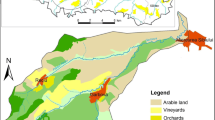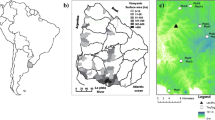Abstract
Most Chinese viticulture regions feature a continental monsoon climate with hot-wet summers and dry-cold winters, giving grapes markedly different growing environments compared to the Mediterranean or oceanic climates. This study investigated the influence of continental climates on the volatile compounds of Vitis vinifera L. cv. Cabernet Sauvignon from five Chinese viticulture regions and the relationship between meteorological metrics and volatile concentrations in the 2014 and 2015 vintages. Grape berries from the climatically similar Wujiaqu (WJQ) and Yuquanying (YQY) regions had similar 6/9-carbon (C6/C9) compound and norisoprenoid contents. Berries from the Yantai (YT) and Jingyang (JY) regions with higher temperature and humidity had higher norisoprenoid contents than those from WJQ and YQY regions. Hierarchical clustering analysis showed that the vintage effect on grape volatile profiles prevailed over the regional effect. Grape berries from climatically similar WJQ and YQY regions exhibited similar volatile profiles and from the Deqin(DQ) region with a specific terroir showed significantly different volatile profiles from those of other regions. Pearson correlation analysis showed that (E)-β-damascenone, β-ionone, hexanal, 2-hexanol, (Z)-3-hexenol and (E)-2-hexenol were closely associated with minimum and maximum temperature, average relative humidity, sunshine duration and frost-free days, suggesting that these compounds might comprise a signature for distinguishing the volatile profiles of grape berries from different regions. This study would enhance our understanding of grape responses to continental monsoon climate through the accumulation of volatiles.


Similar content being viewed by others
References
Bureau SM, Baumes RL, Razungles AJ (2000) Effects of vine or bunch shading on the glycosylated flavor precursors in grapes of Vitis vinifera L. Cv. Syrah J Agric Food Chem 48(4):1290–1297
Cai J, Zhu BQ, Wang YH, Lu L et al (2014) Influence of pre-fermentation cold maceration treatment on aroma compounds of Cabernet Sauvignon wines fermented in different industrial scale fermenters. Food Chem 154:217–229
Corino L, Di Stefano R (1988) Response of white Muscat grapes in relation to various growing environments and evaluation of systems for training and pruning. Rivista Viticolt Enolog 41:72–85
Deis L, Cavagnaro B, Bottini R, Wuilloud R, Fernanda Silva M (2011) Water deficit and exogenous ABA significantly affect grape and wine phenolic composition under in field and in-vitro conditions. Plant Growth Regul 65:11–21
Falginella L, Di Gaspero G, Castellarin SD (2012) Expression of flavonoid genes in the red grape berry of ‘Alicante Bouschet’ varies with the histological distribution of anthocyanins and their chemical composition. Planta 236:1037–1051
Feng H, Yuan F, Skinkis PA, Qian MC (2015) Influence of cluster zone leaf removal on Pinot noir grape chemical and volatile composition. Food Chem 173:414–423
Fraga H, Garcia de Cortazar Atauri I, Malheiro AC, Santos JA (2016) Modelling climate change impacts on viticultural yield, phenology and stress conditions in Europe. Glob Chang Biol 22:3774–3788
Friedel M, Sorrentino V, Blank M, Schuttler A (2016) Influence of berry diameter and colour on some determinants of wine composition of Vitis vinifera L. cv. Riesling Aust J Grape Wine Res 22:215–225
GB/T 15038-2006 (2006) Analytical methods of wine and fruit wine. China Standard Press, Beijing
Gomez E, Martinez A, Laencina J (1995) Changes in volatile compounds during maturation of some grape varieties. J Sci Food Agric 67:229–233
Gonzalez-Barreiro C, Rial OR, Cancho GB, Simal GJ (2015) Wine aroma compounds in grapes: a critical review. Crit Rev Food Sci Nutr 55:202–218
Jackson DI, Lombard PB (1993) Environmental and management-practices affecting grape composition and wine quality—a review. Am J Enol Vitic 44:409–430
Ji T, Dami IE (2008) Characterization of free flavor compounds in Traminette grape and their relationship to vineyard training system and location. J Food Sci 73(4):C262–C267
Jones GV, Davis RE (2000) Climate influences on grapevine phenology, grape composition, and wine production and quality for Bordeaux, France. Am J Enol Vitic 51(3):249–261
Lan YB, Qian X, Yang ZJ, Xiang XF, Yang WX et al (2016) Striking changes in volatile profiles at sub-zero temperatures during over-ripening of ‘Beibinghong’ grapes in Northeastern China. Food Chem 212:172–182
Lasanta C, Caro I, Gomez J, Perez L (2014) The influence of ripeness grade on the composition of musts and wines from Vitis vinifera cv. Tempranillo grown in a warm climate. Food Res Int 64:432–438
Lee SH, Seo MJ, Riu M, Cotta JP et al (2007) Vine microclimate and norisoprenoid concentration in cabernet sauvignon grapes and wines. Am J Enol Vitic 58(3):291–301
Li H, Wang H (2015) Climatic zoning for viticulture in China, Chap. 3, 3rd edn. Northwest A&F University, Yangling
Li Z, Pan QH, Jin ZM, Mu L et al (2011) Comparison on phenolic compounds in Vitis vinifera cv. Cabernet Sauvignon wines from five wine-growing regions in China. Food Chem 125:77–83
Li Q, He F, Zhu BQ, Liu B et al (2014) Comparison of distinct transcriptional expression patterns of flavonoid biosynthesis in Cabernet Sauvignon grapes from east and west China. Plant Physiol Biochem 84:45–56
Mosblech A, Feussner I, Heilmann I (2009) Oxylipins: structurally diverse metabolites from fatty acid oxidation. Plant Physiol Biochem 47:511–517
Reynolds AG, Wardle DA, Dever M (1996) Vine performance, fruit composition, and wine sensory attributes of Gewurztraminer in response to vineyard location and canopy manipulation. Am J Enol Vitic 47(1):77–92
Ristic R, Bindon K, Francis LI, Herderich MJ et al (2010) Flavonoids and C13-norisoprenoids in Vitis vinifera L. cv. Shiraz: relationships between grape and wine composition, wine colour and wine sensory properties. Aust J Grape Wine Res 16:369–388
Sabon I, de Revel G, Kotseridis Y, Bertrand A (2002) Determination of volatile compounds in Grenache wines in relation with different terroirs in the Rhone Valley. J Agric Food Chem 50:6341–6345
Scafidi P, Pisciotta A, Patti D, Tamborra P et al (2013) Effect of artificial shading on the tannin accumulation and aromatic composition of the Grillo cultivar (Vitis vinifera L.). BMC Plant Biol 13:175
Shiojiri K, Kishimoto K, Ozawa R, Kugimiya S et al (2006) Changing green leaf volatile biosynthesis in plants: an approach for improving plant resistance against both herbivores and pathogens. Proc Natl Acad Sci USA 103:16672–16676
van Leeuwen C, Friant P, Chone X, Tregoat O et al (2004) Influence of climate, soil, and cultivar on terroir. Am J Enol Vitic 55:207–217
Wang YJ, Wang L, Liu X, Li YS et al (2018) Climatic regionalization of wine grapes in the Hengduan Mountain region of China. Span J Agric Res 16:0303
Wu YW, Pan QH, Qu WJ, Duan CQ (2009) Comparison of volatile profiles of nine Litchi (Litchi chinensis Sonn.) cultivars from Southern China. J Agric Food Chem 57:9676–9681
Xu XQ, Liu B, Zhu BQ, Lan YB et al (2015) Differences in volatile profiles of Cabernet Sauvignon grapes grown in two distinct regions of China and their responses to weather conditions. Plant Physiol Biochem 89:123–133
Acknowledgements
We are grateful to the Key Laboratory of Viticulture and Enology, Ministry of Agriculture, China (Beijing 100083, China) for access to the HS–SPME with GC–MS equipment.
Funding
This work was supported by the China Agriculture Research System for Grape Industry (CARS-29-zp-6).
Author information
Authors and Affiliations
Corresponding author
Ethics declarations
Conflict of interest
The authors declare no conflict of interest.
Electronic supplementary material
Below is the link to the electronic supplementary material.
Rights and permissions
About this article
Cite this article
Xie, S., Lei, Y., Wang, Y. et al. Influence of continental climates on the volatile profile of Cabernet Sauvignon grapes from five Chinese viticulture regions. Plant Growth Regul 87, 83–92 (2019). https://doi.org/10.1007/s10725-018-0455-8
Received:
Accepted:
Published:
Issue Date:
DOI: https://doi.org/10.1007/s10725-018-0455-8




